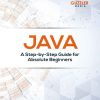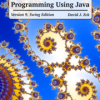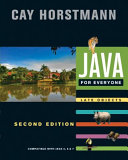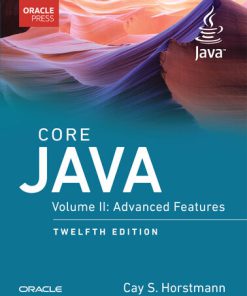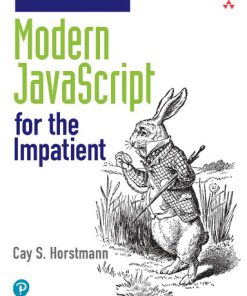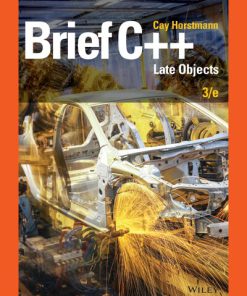Big C late objects Enhanced eText 3rd Edition by Cay Horstmann 1119402905 9781119402909
$50.00 Original price was: $50.00.$25.00Current price is: $25.00.
Big C late objects Enhanced eText 3rd Edition by Cay Horstmann – Ebook PDF Instant Download/Delivery: 1119402905, 9781119402909
Full download Big C late objects Enhanced eText 3rd Edition after payment
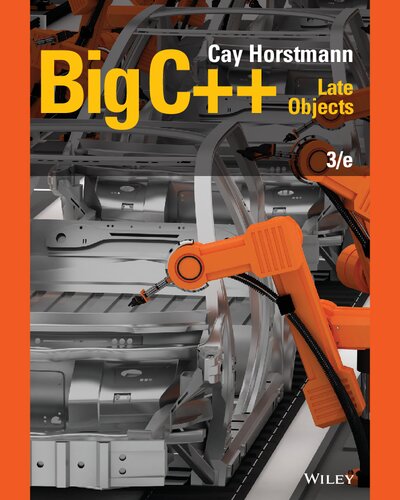
Product details:
ISBN 10: 1119402905
ISBN 13: 9781119402909
Author: Cay S. Horstmann
Big C++: Late Objects, 3rd Edition focuses on the essentials of effective learning and is suitable for a two-semester introduction to programming sequence. This text requires no prior programming experience and only a modest amount of high school algebra. It provides an approachable introduction to fundamental programming techniques and design skills, helping students master basic concepts and become competent coders. The second half covers algorithms and data structures at a level suitable for beginning students. Horstmann and Budd combine their professional and academic experience to guide the student from the basics to more advanced topics and contemporary applications such as GUIs and XML programming. More than a reference, Big C++ provides well-developed exercises, examples, and case studies that engage students in the details of useful C++ applications.
Big C late objects Enhanced eText 3rd Table of contents:
1. Introduction
1.1 What Is Programming?
Self Check
1.2 The Anatomy of a Computer
Self Check
Computing & Society 1.1 Computers Are Everywhere
1.3 Machine Code and Programming Languages
Self Check
Computing & Society 1.2 Standards Organizations
1.4 Becoming Familiar with Your Programming Environment
Self Check
Programming Tip 1.1 Backup Copies
1.5 Analyzing Your First Program
Syntax 1.1 C++ Program
Syntax 1.2 Output Statement
Self Check
Common Error 1.1 Omitting Semicolons
Special Topic 1.1 Escape Sequences
1.6 Errors
Self Check
Common Error 1.2 Misspelling Words
1.7 Problem Solving: Algorithm Design
1.7.1 The Algorithm Concept
1.7.2 An Algorithm for Solving an Investment Problem
1.7.3 Pseudocode
1.7.4 From Algorithms to Programs
Self Check
How To 1.1 Describing an Algorithm with Pseudocode
Worked Example 1.1 Writing an Algorithm for Tiling a Floor
Chapter Summary
Interactive Review and Practice
Practice 1.1
Chapter Review
End-of-Chapter Exercises
Review Exercises
Practice Exercises
Programming Projects
2. Fundamental Data Types
2.1 Variables
2.1.1 Variable Definitions
Syntax 2.1 Variable Definition
Self Check
2.1.2 Number Types
Self Check
2.1.3 Variable Names
Self Check
2.1.4 The Assignment Statement
Syntax 2.2 Assignment
Self Check
2.1.5 Constants
Self Check
2.1.6 Comments
Self Check
Common Error 2.1 Using Undefined Variables
Common Error 2.2 Using Uninitialized Variables
Programming Tip 2.1 Choose Descriptive Variable Names
Programming Tip 2.2 Do Not Use Magic Numbers
Special Topic 2.1 Numeric Types in C++
Special Topic 2.2 Numeric Ranges and Precisions
Special Topic 2.3 Defining Variables with auto
2.2 Arithmetic
2.2.1 Arithmetic Operators
Self Check
2.2.2 Increment and Decrement
Self Check
2.2.3 Integer Division and Remainder
Self Check
2.2.4 Converting Floating-Point Numbers to Integers
Self Check
2.2.5 Powers and Roots
Self Check
Common Error 2.3 Unintended Integer Division
Common Error 2.4 Unbalanced Parentheses
Common Error 2.5 Forgetting Header Files
Common Error 2.6 Roundoff Errors
Programming Tip 2.3 Spaces in Expressions
Special Topic 2.4 Casts
Special Topic 2.5 Combining Assignment and Arithmetic
Computing & Society 2.1 The Pentium Floating-Point Bug
2.3 Input and Output
2.3.1 Input
Syntax 2.3 Input Statement
Self Check
2.3.2 Formatted Output
Self Check
2.4 Problem Solving: First Do It By Hand
Self Check
Worked Example 2.1 Computing Travel Time
How To 2.1 Carrying out Computations
Worked Example 2.2 Computing the Cost of Stamps
2.5 Strings
2.5.1 The string Type
Self Check
2.5.2 Concatenation
Self Check
2.5.3 String Input
Self Check
2.5.4 String Functions
Self Check
Computing & Society 2.2 International Alphabets and Unicode
Chapter Summary
Interactive Review and Practice
Practice 2.1: Variables
Practice 2.2: Arithmetic
Practice 2.3: Formatted Output and Strings
Practice 2.4: First Do It By Hand
Chapter Review
End-of-Chapter Exercises
Review Exercises
Practice Exercises
Programming Projects
3. Decisions
3.1 The if Statement
Syntax 3.1 if Statement
Self Check
Common Error 3.1 A Semicolon After the if Condition
Programming Tip 3.1 Brace Layout
Programming Tip 3.2 Always Use Braces
Programming Tip 3.3 Tabs
Programming Tip 3.4 Avoid Duplication in Branches
Special Topic 3.1 The Conditional Operator
3.2 Comparing Numbers and Strings
Syntax 3.2 Comparisons
Self Check
Common Error 3.2 Confusing = and ==
Common Error 3.3 Exact Comparison of Floating-Point Numbers
Programming Tip 3.5 Compile with Zero Warnings
Special Topic 3.2 Lexicographic Ordering of Strings
How To 3.1 Implementing an if Statement
Worked Example 3.1 Extracting the Middle
Computing & Society 3.1 Dysfunctional Computerized Systems
3.3 Multiple Alternatives
Self Check
Special Topic 3.3 The switch Statement
3.4 Nested Branches
Self Check
Common Error 3.4 The Dangling else Problem
Programming Tip 3.6 Hand-Tracing
3.5 Problem Solving: Flowcharts
Self Check
3.6 Problem Solving: Test Cases
Self Check
Programming Tip 3.7 Make a Schedule and Make Time for Unexpected Problems
3.7 Boolean Variables and Operators
Self Check
Common Error 3.5 Combining Multiple Relational Operators
Common Error 3.6 Confusing && and || Conditions
Special Topic 3.4 Short-Circuit Evaluation of Boolean Operators
Special Topic 3.5 De Morgan’s Law
3.8 Application: Input Validation
Self Check
Computing & Society 3.2 Artificial Intelligence
Chapter Summary
Interactive Review and Practice
Practice 3.1: Simple Conditions
Practice 3.2: Complex Conditions
Practice 3.3: Points on a Line and in a Plane
Chapter Review
End-of-Chapter Exercises
Review Exercises
Practice Exercises
Programming Projects
4. Loops
4.1 The while Loop
Syntax 4.1 while Statement
Self Check
Common Error 4.1 Infinite Loops
Common Error 4.2 Don’t Think “Are We There Yet?”
Common Error 4.3 Off-by-One Errors
Computing & Society 4.1 The First Bug
4.2 Problem Solving: Hand-Tracing
Self Check
4.3 The for Loop
Syntax 4.2 for Statement
Self Check
Programming Tip 4.1 Use for Loops for Their Intended Purpose Only
Programming Tip 4.2 Choose Loop Bounds That Match Your Task
Programming Tip 4.3 Count Iterations
4.4 The do Loop
Self Check
Programming Tip 4.4 Flowcharts for Loops
4.5 Processing Input
4.5.1 Sentinel Values
4.5.2 Reading Until Input Fails
Self Check
Special Topic 4.1 Clearing the Failure State
Special Topic 4.2 The Loop-and-a-Half Problem and the break Statement
Special Topic 4.3 Redirection of Input and Output
4.6 Problem Solving: Storyboards
Self Check
4.7 Common Loop Algorithms
4.7.1 Sum and Average Value
Self Check
4.7.2 Counting Matches
Self Check
4.7.3 Finding the First Match
Self Check
4.7.4 Prompting Until a Match is Found
Self Check
4.7.5 Maximum and Minimum
Self Check
4.7.6 Comparing Adjacent Values
Self Check
How To 4.1 Writing a Loop
Worked Example 4.1 Credit Card Processing
4.8 Nested Loops
Self Check
Worked Example 4.2 Manipulating the Pixels in an Image
4.9 Problem Solving: Solve a Simpler Problem First
Self Check
4.10 Random Numbers and Simulations
4.10.1 Generating Random Numbers
Self Check
4.10.2 Simulating Die Tosses
Self Check
4.10.3 The Monte Carlo Method
Self Check
Computing & Society 4.2 Digital Piracy
Chapter Summary
Interactive Review and Practice
Practice 4.1: while Loops
Practice 4.2: Loop Tracing
Practice 4.3: for Loops
Practice 4.4: do/while Loops
Practice 4.5: Algorithms
Practice 4.6: Nested Loops
Practice 4.7: Solve a Simpler Problem First
Practice 4.8: Random Numbers
Chapter Review
End-of-Chapter Exercises
Review Exercises
Practice Exercises
Programming Projects
5. Functions
5.1 Functions as Black Boxes
Self Check
5.2 Implementing Functions
Syntax 5.1 Function Definition
Self Check
Programming Tip 5.1 Function Comments
5.3 Parameter Passing
Self Check
Programming Tip 5.2 Do Not Modify Parameter Variables
5.4 Return Values
Self Check
Common Error 5.1 Missing Return Value
Special Topic 5.1 Function Declarations
How To 5.1 Implementing a Function
Worked Example 5.1 Generating Random Passwords
Worked Example 5.2 Using a Debugger
5.5 Functions Without Return Values
Self Check
5.6 Problem Solving: Reusable Functions
Self Check
5.7 Problem Solving: Stepwise Refinement
Self Check
Programming Tip 5.3 Keep Functions Short
Programming Tip 5.4 Tracing Functions
Programming Tip 5.5 Stubs
Worked Example 5.3 Calculating a Course Grade
5.8 Variable Scope and Global Variables
Self Check
Programming Tip 5.6 Avoid Global Variables
5.9 Reference Parameters
Self Check
Programming Tip 5.7 Prefer Return Values to Reference Parameters
Special Topic 5.2 Constant References
5.10 Recursive Functions (Optional)
Self Check
How To 5.2 Thinking Recursively
Computing & Society 5.1 The Explosive Growth of Personal Computers
Chapter Summary
Interactive Review and Practice
Practice 5.1: Simple Methods
Practice 5.2: Reuse and Refinement
Practice 5.3: Recursion
Chapter Review
End-of-Chapter Exercises
Review Exercises
Practice Exercises
Programming Projects
6. Arrays and Vectors
6.1 Arrays
6.1.1 Defining Arrays
Syntax 6.1 Defining an Array
Self Check
6.1.2 Accessing Array Elements
Self Check
6.1.3 Partially Filled Arrays
Self Check
Common Error 6.1 Bounds Errors
Programming Tip 6.1 Use Arrays for Sequences of Related Values
Computing & Society 6.1 Computer Viruses
6.2 Common Array Algorithms
6.2.1 Filling
Self Check
6.2.2 Copying
6.2.3 Sum and Average Value
6.2.4 Maximum and Minimum
Self Check
6.2.5 Element Separators
6.2.6 Counting Matches
Self Check
6.2.7 Linear Search
Self Check
6.2.8 Removing an Element
Self Check
6.2.9 Inserting an Element
Self Check
6.2.10 Swapping Elements
Self Check
6.2.11 Reading Input
Special Topic 6.1 Sorting with the C++ Library
Special Topic 6.2 A Sorting Algorithm
Special Topic 6.3 Binary Search
6.3 Arrays and Functions
Self Check
Special Topic 6.4 Constant Array Parameters
6.4 Problem Solving: Adapting Algorithms
Self Check
How To 6.1 Working with Arrays
Worked Example 6.1 Rolling the Dice
6.5 Problem Solving: Discovering Algorithms by Manipulating Physical Objects
Self Check
6.6 Two-Dimensional Arrays
6.6.1 Defining Two-Dimensional Arrays
Syntax 6.2 Two-Dimensional Array Definition
Self Check
6.6.2 Accessing Elements
Self Check
6.6.3 Locating Neighboring Elements
Self Check
6.6.4 Computing Row and Column Totals
Self Check
6.6.5 Two-Dimensional Array Parameters
Self Check
Common Error 6.2 Omitting the Column Size of a Two-Dimensional Array Parameter
Worked Example 6.2 A World Population Table
6.7 Vectors
6.7.1 Defining Vectors
Syntax 6.3 Defining a Vector
Self Check
6.7.2 Growing and Shrinking Vectors
Self Check
6.7.3 Vectors and Functions
Self Check
6.7.4 Vector Algorithms
Self Check
6.7.5 Two-Dimensional Vectors
Self Check
Programming Tip 6.2 Prefer Vectors over Arrays
Special Topic 6.5 The Range-Based for Loop
Chapter Summary
Interactive Review and Practice
Practice 6.1: Simple Arrays
Practice 6.2: Algorithms
Practice 6.3: Adapting Algorithms
Practice 6.4: Two-Dimensional Arrays
Practice 6.5: Vectors
Chapter Review
End-of-Chapter Exercises
Review Exercises
Practice Exercises
Programming Projects
7. Pointers and Structures
7.1 Defining and Using Pointers
7.1.1 Defining Pointers
7.1.2 Accessing Variables Through Pointers
Syntax 7.1 Pointer Syntax
7.1.3 Initializing Pointers
Self Check
Common Error 7.1 Confusing Pointers with the Data to Which They Point
Programming Tip 7.1 Use a Separate Definition for Each Pointer Variable
Special Topic 7.1 Pointers and References
7.2 Arrays and Pointers
7.2.1 Arrays as Pointers
7.2.2 Pointer Arithmetic
7.2.3 Array Parameter Variables Are Pointers
Self Check
Special Topic 7.2 Using a Pointer to Step Through an Array
Common Error 7.2 Returning a Pointer to a Local Variable
Programming Tip 7.2 Program Clearly, Not Cleverly
Special Topic 7.3 Constant Pointers
7.3 C and C++ Strings
7.3.1 The char Type
7.3.2 C Strings
7.3.3 Character Arrays
7.3.4 Converting Between C and C++ Strings
7.3.5 C++ Strings and the [] Operator
Self Check
Special Topic 7.4 Working with C Strings
7.4 Dynamic Memory Allocation
Syntax 7.2 Dynamic Memory Allocation
Self Check
Common Error 7.3 Dangling Pointers
Common Error 7.4 Memory Leaks
7.5 Arrays and Vectors of Pointers
Self Check
7.6 Problem Solving: Draw a Picture
Self Check
How To 7.1 Working with Pointers
Worked Example 7.1 Producing a Mass Mailing
Computing & Society 7.1 Embedded Systems
7.7 Structures
7.7.1 Structured Types
Syntax 7.3 Defining a Structure
7.7.2 Structure Assignment and Comparison
7.7.3 Functions and Structures
7.7.4 Arrays of Structures
7.7.5 Structures with Array Members
7.7.6 Nested Structures
Self Check
7.8 Pointers and Structures
7.8.1 Pointers to Structures
7.8.2 Structures with Pointer Members
Self Check
Special Topic 7.5 Smart Pointers
Chapter Summary
Interactive Review and Practice
Chapter Review
End-of-Chapter Exercises
Review Exercises
Practice Exercises
Programming Projects
8. Streams
8.1 Reading and Writing Text Files
8.1.1 Opening a Stream
8.1.2 Reading from a File
Syntax 8.1 Working with File Streams
8.1.3 Writing to a File
8.1.4 A File Processing Example
Self Check
8.2 Reading Text Input
8.2.1 Reading Words
Self Check
8.2.2 Reading Characters
Self Check
8.2.3 Reading Lines
Self Check
Common Error 8.1 Mixing >> and getline Input
Special Topic 8.1 Stream Failure Checking
8.3 Writing Text Output
Self Check
Special Topic 8.2 Unicode, UTF-8, and C++ Strings
8.4 Parsing and Formatting Strings
Self Check
8.5 Command Line Arguments
Self Check
Computing & Society 8.1 Encryption Algorithms
How To 8.1 Processing Text Files
Worked Example 8.1 Looking for for Duplicates
8.6 Random Access and Binary Files
8.6.1 Random Access
8.6.2 Binary Files
8.6.3 Processing Image Files
Self Check
Computing & Society 8.2 Databases and Privacy
Chapter Summary
Interactive Review and Practice
Practice 8.1: Reading and Writing Files
Practice 8.2: Text Input and Output
Chapter Review
End-of-Chapter Exercises
Review Exercises
Practice Exercises
Programming Projects
9. Classes
9.1 Object-Oriented Programming
Self Check
9.2 Implementing a Simple Class
Self Check
9.3 Specifying the Public Interface of a Class
Syntax 9.1 Class Definition
Self Check
Common Error 9.1 Forgetting a Semicolon
9.4 Designing the Data Representation
Self Check
9.5 Member Functions
9.5.1 Implementing Member Functions
9.5.2 Implicit and Explicit Parameters
9.5.3 Calling a Member Function from a Member Function
Syntax 9.2 Member Function Definition
Self Check
Programming Tip 9.1 All Data Members Should Be Private; Most Member Functions Should Be Public
Programming Tip 9.2 const Correctness
9.6 Constructors
Self Check
Common Error 9.2 Trying to Call a Constructor
Special Topic 9.1 Overloading
Special Topic 9.2 Initializer Lists
Special Topic 9.3 Universal and Uniform Initialization Syntax
9.7 Problem Solving: Tracing Objects
Self Check
How To 9.1 Implementing a Class
Worked Example 9.1 Implementing a Bank Account Class
Computing & Society 9.1 Electronic Voting Machines
9.8 Problem Solving: Discovering Classes
Self Check
Programming Tip 9.3 Make Parallel Vectors into Vectors of Objects
9.9 Separate Compilation
Self Check
9.10 Pointers to Objects
9.10.1 Dynamically Allocating Objects
9.10.2 The -> Operator
9.10.3 The this Pointer
Self Check
9.11 Problem Solving: Patterns for Object Data
9.11.1 Keeping a Total
Self Check
9.11.2 Counting Events
Self Check
9.11.3 Collecting Values
Self Check
9.11.4 Managing Properties of an Object
Self Check
9.11.5 Modeling Objects with Distinct States
Self Check
9.11.6 Describing the Position of an Object
Self Check
Computing & Society 9.2 Open Source and Free Software
Chapter Summary
Interactive Review and Practice
Practice 9.1: Understanding Classes
Practice 9.2: Implementing Classes
Chapter Review
End-of-Chapter Exercises
Review Exercises
Practice Exercises
Programming Projects
10. Inheritance
10.1 Inheritance Hierarchies
Self Check
10.2 Implementing Derived Classes
Syntax 10.1 Derived-Class Definition
Self Check
Common Error 10.1 Private Inheritance
Common Error 10.2 Replicating Base-Class Members
Programming Tip 10.1 Use a Single Class for Variation in Values, Inheritance for Variation in Behavior
Special Topic 10.1 Calling the Base-Class Constructor
Syntax 10.2 Constructor with Base-Class Initializer
10.3 Overriding Member Functions
Self Check
Common Error 10.3 Forgetting the Base-Class Name
10.4 Virtual Functions and Polymorphism
10.4.1 The Slicing Problem
10.4.2 Pointers to Base and Derived Classes
10.4.3 Virtual Functions
10.4.4 Polymorphism
Self Check
Programming Tip 10.2 Don’t Use Type Tags
Common Error 10.4 Slicing an Object
Common Error 10.5 Failing to Override a Virtual Function
Special Topic 10.2 Virtual Self-Calls
How To 10.1 Developing an Inheritance Hierarchy
Worked Example 10.1 Implementing an Employee Hierarchy for Payroll Processing
Computing & Society 10.1 Who Controls the Internet?
Chapter Summary
Interactive Review and Practice
Practice 10.1: Inheritance
Practice 10.2: Polymorphism
Chapter Review
End-of-Chapter Exercises
Review Exercises
Practice Exercises
Programming Projects
11. Recursion
11.1 Triangle Numbers
Self Check
Common Error 11.1 Tracing Through Recursive Functions
Common Error 11.2 Infinite Recursion
How To 11.1 Thinking Recursively
Worked Example 11.1 Finding Files
11.2 Recursive Helper Functions
Self Check
11.3 The Efficiency of Recursion
Self Check
11.4 Permutations
Self Check
11.5 Mutual Recursion
Self Check
11.6 Backtracking
Self Check
Worked Example 11.2 Towers of Hanoi
Computing & Society 11.1 The Limits of Computation
Chapter Summary
Interactive Review and Practice
Practice 11.1: Simple Recursion
Practice 11.2: Complex Recursion
Chapter Review
End-of-Chapter Exercises
Review Exercises
Practice Exercises
Programming Projects
12. Sorting and Searching
12.1 Selection Sort
Self Check
12.2 Profiling the Selection Sort Algorithm
Self Check
12.3 Analyzing the Performance of the Selection Sort Algorithm
Self Check
Special Topic 12.1 Oh, Omega, and Theta
Special Topic 12.2 Insertion Sort
12.4 Merge Sort
Self Check
12.5 Analyzing the Merge Sort Algorithm
Self Check
Special Topic 12.3 The Quicksort Algorithm
12.6 Searching
12.6.1 Linear Search
12.6.2 Binary Search
Self Check
Programming Tip 12.1 Library Functions for Sorting and Binary Search
Special Topic 12.4 Defining an Ordering for Sorting Objects
12.7 Problem Solving: Estimating the Running Time of an Algorithm
12.7.1 Linear Time
12.7.2 Quadratic Time
12.7.3 The Triangle Pattern
12.7.4 Logarithmic Time
Self Check
Worked Example 12.1 Enhancing the Insertion Sort Algorithm
Computing & Society 12.1 The First Programmer
Chapter Summary
Interactive Review and Practice
Practice 12.1: Additional Practice
Chapter Review
End-of-Chapter Exercises
Review Exercises
Practice Exercises
Programming Projects
13. Advanced C++
13.1 Operator Overloading
13.1.1 Operator Functions
Syntax 13.1 Overloaded Operator Definition
13.1.2 Overloading Comparison Operators
13.1.3 Input and Output
13.1.4 Operator Members
Self Check
Special Topic 13.1 Overloading Increment and Decrement Operators
Special Topic 13.2 Implicit Type Conversions
Special Topic 13.3 Returning References
Worked Example 13.1 A Fraction Class
13.2 Automatic Memory Management
13.2.1 Constructors That Allocate Memory
13.2.2 Destructors
Syntax 13.2 Destructor Definition
13.2.3 Overloading the Assignment Operator
Syntax 13.3 Overloaded Assignment Operator
13.2.4 Copy Constructors
Syntax 13.4 Copy Constructor
Self Check
Programming Tip 13.1 Use Reference Parameters To Avoid Copies
Common Error 13.1 Defining a Destructor Without the Other Two Functions of the “Big Three”
Special Topic 13.4 Virtual Destructors
Special Topic 13.5 Suppressing Automatic Generation of Memory Management Functions
Special Topic 13.6 Move Operations
Special Topic 13.7 Shared Pointers
Worked Example 13.2 Tracing Memory Management of Strings
13.3 Templates
13.3.1 Function Templates
Syntax 13.5 Function Template
13.3.2 Class Templates
Syntax 13.6 Class Template
Self Check
Special Topic 13.8 Non-Type Template Parameters
Chapter Summary
Interactive Review and Practice
Chapter Review
End-of-Chapter Exercises
Review Exercises
Practice Exercises
Programming Projects
14. Linked Lists, Stacks, and Queues
14.1 Using Linked Lists
Self Check
14.2 Implementing Linked Lists
14.2.1 The Classes for Lists, Nodes, and Iterators
14.2.2 Implementing Iterators
14.2.3 Implementing Insertion and Removal
Self Check
Worked Example 14.1 Implementing a Linked List Template
14.3 The Efficiency of List, Array, and Vector Operations
Self Check
14.4 Stacks and Queues
Self Check
14.5 Implementing Stacks and Queues
14.5.1 Stacks as Linked Lists
14.5.2 Stacks as Arrays
14.5.3 Queues as Linked Lists
14.5.4 Queues as Circular Arrays
Self Check
14.6 Stack and Queue Applications
14.6.1 Balancing Parentheses
14.6.2 Evaluating Reverse Polish Expressions
14.6.3 Evaluating Algebraic Expressions
14.6.4 Backtracking
Self Check
Special Topic 14.1 Reverse Polish Notation
Chapter Summary
Interactive Review and Practice
Practice 14.1: Additional Practice
Chapter Review
End-of-Chapter Exercises
Review Exercises
Practice Exercises
Programming Projects
15. Sets, Maps, and Hash Tables
15.1 Sets
Self Check
15.2 Maps
Self Check
Programming Tip 15.1 Use the auto Type for Iterators
Special Topic 15.1 Multisets and Multimaps
Worked Example 15.1 Word Frequency
15.3 Implementing a Hash Table
15.3.1 Hash Codes
15.3.2 Hash Tables
15.3.3 Finding an Element
15.3.4 Adding and Removing Elements
15.3.5 Iterating over a Hash Table
Self Check
Special Topic 15.2 Implementing Hash Functions
Special Topic 15.3 Open Addressing
Chapter Summary
Interactive Review and Practice
Chapter Review
End-of-Chapter Exercises
Review Exercises
Practice Exercises
Programming Projects
16. Tree Structures
16.1 Basic Tree Concepts
Self Check
16.2 Binary Trees
16.2.1 Binary Tree Examples
16.2.2 Balanced Trees
16.2.3 A Binary Tree Implementation
Self Check
Worked Example 16.1 Building a Huffman Tree
16.3 Binary Search Trees
16.3.1 The Binary Search Property
16.3.2 Insertion
16.3.3 Removal
16.3.4 Efficiency of the Operations
Self Check
16.4 Tree Traversal
16.4.1 Inorder Traversal
16.4.2 Preorder and Postorder Traversals
16.4.3 The Visitor Pattern
16.4.4 Depth-First and Breadth-First Search
16.4.5 Tree Iterators
Self Check
16.5 Red-Black Trees
16.5.1 Basic Properties of Red-Black Trees
16.5.2 Insertion
16.5.3 Removal
Self Check
Worked Example 16.2 Implementing a Red-Black Tree
Chapter Summary
Interactive Review and Practice
Chapter Review
End-of-Chapter Exercises
Review Exercises
Practice Exercises
Programming Projects
17. Priority Queues and Heaps
17.1 Priority Queues
Self Check
Worked Example 17.1 Simulating a Queue of Waiting Customers
17.2 Heaps
Self Check
17.3 The Heapsort Algorithm
Self Check
Chapter Summary
Interactive Review and Practice
Chapter Review
End-of-Chapter Exercises
Review Exercises
Practice Exercises
Programming Projects
Appendix A: Reserved Word Summary
Appendix B: Operator Summary
Appendix C: Character Codes
Appendix D: C++ Library Summary
Appendix E: C++ Language Coding Guidelines
Introduction
Source Files
Functions
Local Variables
Constants
Classes
Control Flow
Lexical Issues
Appendix F: Number Systems
Binary Numbers
Long, Short, Signed, and Unsigned Integers
Two’s Complement Integers
IEEE Floating-Point Numbers
Hexadecimal Numbers
Bit and Shift Operations
Glossary
Illustration Credits
Wiley End User License Agreement
People also search for Big C late objects Enhanced eText 3rd:
big c ++ late objects enhanced etext 3rd edition
big c ++ late objects enhanced etext 3rd edition pdf
big c++ late objects 3rd edition pdf
big c++ late objects 3rd edition free pdf
Tags:
Cay Horstmann,objects,Enhanced,Big C
You may also like…
Computers - Programming
Java For Everyone Late Objects 1st Edition by Cay Horstmann ISBN 1118129415 9781118063316
Computers - Programming
Core Java Vol II Advanced Feature 12th Edition by Cay Horstmann 0137870965 9780137870967
Computers - Web Development
Modern JavaScript for the Impatient 1st Edition Cay S. Horstmann
Computers - Programming
Computers - Programming
Big Java Late Objects 2nd Edition by Cay Horstmann ISBN 1119321077 9781119321071
Computers - Programming
Uncategorized
Computers - Programming
C++20 for Programmers: An Objects-Natural Approach 3rd Edition Paul Deitel

